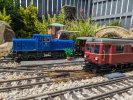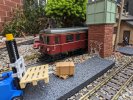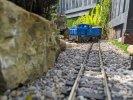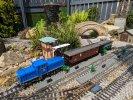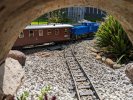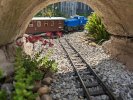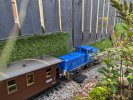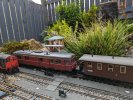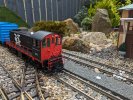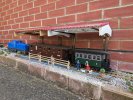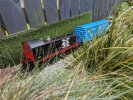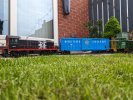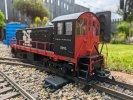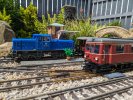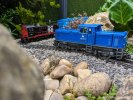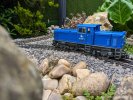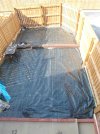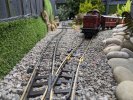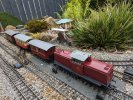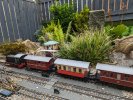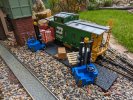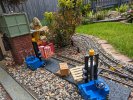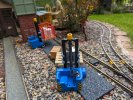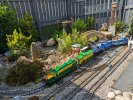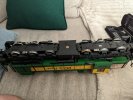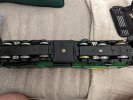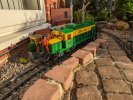You are using an out of date browser. It may not display this or other websites correctly.
You should upgrade or use an alternative browser.
You should upgrade or use an alternative browser.
The Woodlock Line
- Thread starter duncan1_9_8_4
- Start date
duncan1_9_8_4
Garden Railway Operator
duncan1_9_8_4
Garden Railway Operator
Rhinochugger
Retired Oik
I think it compacts down a fair bitAnd once again, the ballast train has done its rounds. Serious question, where does all the ballast go? Seems I constantly top it up, for near on 10 years.....View attachment 313402View attachment 313403View attachment 313404View attachment 313405View attachment 313406
duncan1_9_8_4
Garden Railway Operator
duncan1_9_8_4
Garden Railway Operator
Chris Vernell
45.29 N, 75.75 W
Where's my electric mouse? They promised me an electric mouse.
duncan1_9_8_4
Garden Railway Operator
Greg Elmassian
Guest
Is it really underpowered, or is it suffering from the R1 curves?
is the powertrain different, i.e. different motor, different gearing?
is the powertrain different, i.e. different motor, different gearing?
GAP
G Scale Model Trains, 1:1 Sugar Cane Trains
Good to see the site supervisor has a paw on the pulse making sure all is running smoothly.A bit of White Pass today, with a disappointingly under powered locomotive. Might try getting another wheel set with a tire on, so that both bogies have a tire.View attachment 313716View attachment 313717View attachment 313718
duncan1_9_8_4
Garden Railway Operator
It's really underpowered. Couldn't be on a longer, straighter piece of track and it just grinds to a halt with 3 wagons, where others run fine, with more wagons.Is it really underpowered, or is it suffering from the R1 curves?
is the powertrain different, i.e. different motor, different gearing?
For a long time, I've been disappointed with LGB and the poor adhesion on trains even with traction tires, when compared to other brands, such as USAT who haven't put tires on their Switchers, but are capable of hauling massive loads up steep hills.
I've ran LGB alongside other makes for nearly 20 years now, and have always found LGB to be poor on the adhesion front.
With this locomotive in particular, all the weight is over the rear bogie, the tire was on the front bogie. So I moved the tire wheel to the rear bogie and it's now a bit better, but there's still hardly any weight over the front, and it's now without tire too. Seems in this case to be poorly distributed weight.
What do I know though..... Eh? It upsets the LGB elite, but in my opinion, they're just not brilliant at gripping, even with tires.
(based on 20 years experience of running USAT, LGB, Bachmann and Aristocraft)
Put it like this, my very light, in comparison Bachmann Lyn, can pull double, without struggle, and without tires.
Last edited:
It does seem odd that the weight distribution is wrong, there is a missing weight is there?It's really underpowered. Couldn't be on a longer, straighter piece of track and it just grinds to a halt with 3 wagons, where others run fine, with more wagons.
For a long time, I've been disappointed with LGB and the poor adhesion on trains even with traction tires, when compared to other brands, such as USAT who haven't put tires on their Switchers, but are capable of hauling massive loads up steep hills.
I've ran LGB alongside other makes for nearly 20 years now, and have always found LGB to be poor on the adhesion front.
With this locomotive in particular, all the weight is over the rear bogie, the tire was on the front bogie. So I moved the tire wheel to the rear bogie and it's now a bit better, but there's still hardly any weight over the front, and it's now without tire too. Seems in this case to be poorly distributed weight.
What do I know though..... Eh? It upsets the LGB elite, but in my opinion, they're just not brilliant at gripping, even with tires.
(based on 20 years experience of running USAT, LGB, Bachmann and Aristocraft)
Put it like this, my very light, in comparison Bachmann Lyn, can pull double, without struggle, and without tires.
duncan1_9_8_4
Garden Railway Operator
No, no space for any more weights. Just the big block in the undercarriage, what would be the fuel tank in real life.It does seem odd that the weight distribution is wrong, there is a missing weight is there?
Greg Elmassian
Guest
I did fill the fuel tanks on several diesels with lead, but LGB seems to engineer drivetrain to expected load.... adding a lot of weight might overstress axle bearings (if there are even any) or the gear teeth.
Remember the Mikado? When they did the Aster version with a heavy brass shell? Ate gears and drivetrains for lunch... was fine with lighter plastic boiler and tender.
Good to be forwarned about the pulling power and discrepancy in location of traction tires.
Thanks! Greg
Remember the Mikado? When they did the Aster version with a heavy brass shell? Ate gears and drivetrains for lunch... was fine with lighter plastic boiler and tender.
Good to be forwarned about the pulling power and discrepancy in location of traction tires.
Thanks! Greg
duncan1_9_8_4
Garden Railway Operator
I didn't really think anything of it, but when you pick up a locomotive in its centre, they normally feel pretty much evenly balanced with regards weight. This locomotive however, tilts back leaving the cab in the air, if that makes sense, with hardly any weight over the cab end bogie, which is where the tire was. So while there was a tire, the lack of weight made the tire almost pointless.I did fill the fuel tanks on several diesels with lead, but LGB seems to engineer drivetrain to expected load.... adding a lot of weight might overstress axle bearings (if there are even any) or the gear teeth.
Remember the Mikado? When they did the Aster version with a heavy brass shell? Ate gears and drivetrains for lunch... was fine with lighter plastic boiler and tender.
Good to be forwarned about the pulling power and discrepancy in location of traction tires.
Thanks! Greg
duncan1_9_8_4
Garden Railway Operator
AlanL
Registered
Hi Duncan, I have two versions of this loco and have tried the 'weight distribution test' by balancing them below the centre of the fuel tank. Both of my locos don't show any bias of weight to one end or another. This begs the question, has your loco had weights removed?
But there is more to this loco than weight and traction tyres.
The bogie pivots are not central but about 3/4 of an inch behind the end axle. This means that around 80% of the loco weight is on the end axles.
In addition the centre axles are sprung heavily and affect the tractive effort.
When I first aquired my 108 loco I too was disappointed with the hauling power and investigated.
The biggest improvement was obtained by running the loco with the centre axle totally removed. The difference in hauling power was imediately improved by a massive amount.
Perhaps your loco now is working okay with your relatively short trains but to anyone else who has this lack of tractive effort, |I would suggest removing the centre axles from both bogies and see for yourself the difference.
My final solution was to slightly re-shape the springs for the centre axles so that there was minimal downward pressure, the springs merely stopped the wheels from lifting. The centre axles also need the springs to stop the axle bushing rotating. Running the loco without the springs caused problems that I can't remember.
Photo of loco 103 without any traction tyres -
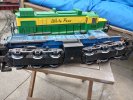
Neither of my locos have traction tyres and below is a photo of 103 pulling a train of 7 Bachmann hoppers plus a caboose up a 2.5% incline. Sorry the train is mainly hidden but that's the only position I could capture it fully on the incline.
Loco 108 is normally at the other end but I just tried this quickly this morning -

Alan
But there is more to this loco than weight and traction tyres.
The bogie pivots are not central but about 3/4 of an inch behind the end axle. This means that around 80% of the loco weight is on the end axles.
In addition the centre axles are sprung heavily and affect the tractive effort.
When I first aquired my 108 loco I too was disappointed with the hauling power and investigated.
The biggest improvement was obtained by running the loco with the centre axle totally removed. The difference in hauling power was imediately improved by a massive amount.
Perhaps your loco now is working okay with your relatively short trains but to anyone else who has this lack of tractive effort, |I would suggest removing the centre axles from both bogies and see for yourself the difference.
My final solution was to slightly re-shape the springs for the centre axles so that there was minimal downward pressure, the springs merely stopped the wheels from lifting. The centre axles also need the springs to stop the axle bushing rotating. Running the loco without the springs caused problems that I can't remember.
Photo of loco 103 without any traction tyres -

Neither of my locos have traction tyres and below is a photo of 103 pulling a train of 7 Bachmann hoppers plus a caboose up a 2.5% incline. Sorry the train is mainly hidden but that's the only position I could capture it fully on the incline.
Loco 108 is normally at the other end but I just tried this quickly this morning -

Alan
Rhinochugger
Retired Oik
Was that a bit of a mistake getting tired wheels? I'd have made sure they were wide awake, meself 

duncan1_9_8_4
Garden Railway Operator
This is very good advice. Going to do some more tests with my other which isn't brilliant either. Does it visually affect the look having the central axle removed?Hi Duncan, I have two versions of this loco and have tried the 'weight distribution test' by balancing them below the centre of the fuel tank. Both of my locos don't show any bias of weight to one end or another. This begs the question, has your loco had weights removed?
But there is more to this loco than weight and traction tyres.
The bogie pivots are not central but about 3/4 of an inch behind the end axle. This means that around 80% of the loco weight is on the end axles.
In addition the centre axles are sprung heavily and affect the tractive effort.
When I first aquired my 108 loco I too was disappointed with the hauling power and investigated.
The biggest improvement was obtained by running the loco with the centre axle totally removed. The difference in hauling power was imediately improved by a massive amount.
Perhaps your loco now is working okay with your relatively short trains but to anyone else who has this lack of tractive effort, |I would suggest removing the centre axles from both bogies and see for yourself the difference.
My final solution was to slightly re-shape the springs for the centre axles so that there was minimal downward pressure, the springs merely stopped the wheels from lifting. The centre axles also need the springs to stop the axle bushing rotating. Running the loco without the springs caused problems that I can't remember.
Photo of loco 103 without any traction tyres -
View attachment 313881
Neither of my locos have traction tyres and below is a photo of 103 pulling a train of 7 Bachmann hoppers plus a caboose up a 2.5% incline. Sorry the train is mainly hidden but that's the only position I could capture it fully on the incline.
Loco 108 is normally at the other end but I just tried this quickly this morning -
View attachment 313882
Alan

